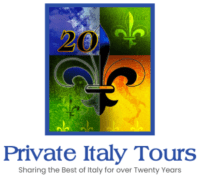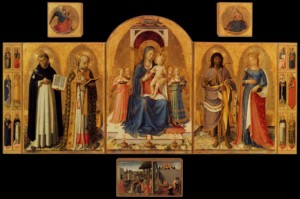His contemporaries called him Fra Giovanni; after his death, angels joined his name. Guido di Pietro was born in a small village in the Mugello area of Tuscany. As an adult, he joined a confraternity associated with the Carmine order where assumed the name of Fra Giovanni, Brother John. He lived a devout an inconspicuous life as a diminutive monk in the Dominican Monastery in Fiesole within sight of central Florence.
In 1436, with a move to the Dominican Monastery of San Marco in Florence, his career as an artist gained momentum. Once Cosimo de Medici met the young friar and studied his work, Fra Giovanni received the commission to decorate the monastery, beginning with the monk’s cells on the upper floor of the complex. In total, thirty-nine frescoes were painted, one in each cell depicting various moments from the life of Christ.
Within this cycle of frescoes, the cell used for retreat by Cosimo de Medici has scenes of particular note. It combines Adoration of the Magi and Man of Sorrows. Adoration of the Magi depicts the arrival of royalty bearing valuable gifts to the Christ Child. Cosimo requested this scene to remind himself to always behave in a manner acknowledging the source of his wealth and power. Man of Sorrows, added after the Adoration of the Magi, depicts Christ wearing the Crown of Thorns, yet another reminder to the leader of the Medici family that suffering is but a part of Christian faith.
In the course of construction within the monastic complex, Angelico painted one of his masterpieces, Crucifixion with Saints. A complex fresco of enormous scale (nearly 30 feet wide by 19 feet high), it represents a stunning and breathtaking example of his facility with fresco as an art form.
As his fame grew, so did his commissions. In the middle of the 15th Century, the Vatican called him to Rome to work for Pope Eugenius IV where he decorated several rooms, only two of which are extant. In the midst of his work in Rome, he traveled to the Umbrian city of Perugia, where he completed the Altarpiece for the Chapel of St. Nicholas in the Basilica of San Domenico.
This is a monumental and complex work housed in a frame covered in gold leaf. The artist surrounded the central figure of Mary and the Christ child (referred to as “Maesta”) by paintings of St. Dominic and Nicholas on the left, St. John the Baptist and St. Catherine of Alexandria on the right. Many experts attribute Dominic and Nicholas to the master, the Baptist and St. Catherine to those in Angelico’s workshop. Regardless, it is a stunning piece of art, a masterpiece that further underscores Angelico’s immense talents.
In the latter years of his life, he moved between Rome (frescoes in the Cappella Niccolina of the Vatican), Florence as Prior of Fiesole’s Dominican Monastery, and Umbria. He returned to Rome where he settled until his death in 1455.
Those who assessed the incredible talents of Fra Giovanni after his death gave him the titles of “Fra Angelico” or “Beat Angelico”. The Dominican theologian, Thomas Acquinas, bestowed upon the lowly monk from the Mugello the title, Angelic Doctor, Beat Angelico, in tribute.
As a contemporary of Massacio, Fra Giovanni established many of the approaches to the art of fresco that persisted throughout the 14th and 15th Centuries in Renaissance Italy.
I have spent hours upon hours in the monastic complex of San Marco in Florence. Early in the morning, before others arrive, I climb the stairs that lead to the level of the monk’s cells. When I gaze upon the shimmering, sandal polished floors and study the early sunlit beauty of Angelico’s frescoes in each cell, I feel both a spiritual calm and a profound sense of the incredible talent of this 15th Century artist. Inspired by his profound faith, he used the gifts of God to inspire a world that, to this day, stands in awe.




